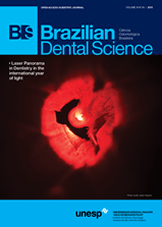The effect of metal surface treatment on bond strength interface between metal/cement
DOI:
https://doi.org/10.14295/bds.2015.v18i4.1187Abstract
Objective: This study evaluated the hypothesis that different treatments of surface upon three metal alloys for metal ceramic dental prostheses (Gold; Nickel-Chromium; Titanium) do not Influence the values of bond strength with resin cement. Material and Methods: Twenty blocks, 5x5x5 mm, of each alloy were divided into two subgroups (n = 10) according to surface treatments: 1 (Primer): sandblasting with aluminum oxide particles 110 µm (Al2O3) + Alloy Primer (Kuraray); 2 (Cojet): sandblasting with silica oxide particles with Cojet-Sand + Silane ESPE-Sil. The conditioned blocks of each group were cemented, with Panavia F, to resin blocks under constant load of 750 g/10 min. The sets were cut to obtain 4 samples with dimensions of 10x1x1 mm per block (n = 10) and the adhesive surface with approximately 1 mm2. The microtensile test was done in the universal testing machine at 1 mm/min crosshead speed. The values of bond strength and standard deviation (MPa) were: Au P: 7.33 ± 1.93d; Au C: 13.35 ± 2.18c; NiCr P: 23.56 ± 6.5b; NiCr C: 42.6 ± 5.84a; Ti P: 26.17 ± 1.94b; Ti C: 44.30 ± 2.3a. Data were analyzed by variance test (ANOVA) and Tukey’s test, p < 0.05. Results: The results indicated that the conditioning with treatment 2 increased the bond strength between the resin cement and alloys. The lowest bond strengths values were obtained with gold alloy, regardless the surface treatment. Conclusion: The results denied the hypothesis that the metallic alloys surface treatments do not alter the bond strengths values.
Downloads
Downloads
Published
How to Cite
Issue
Section
License
Brazilian Dental Science uses the Creative Commons (CC-BY 4.0) license, thus preserving the integrity of articles in an open access environment. The journal allows the author to retain publishing rights without restrictions.
=================




























